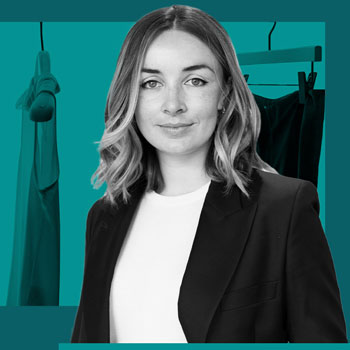
The Financial Times has a strong roster of newsletters, covering many of the topics you might expect, such as business, finance or trade. But when I joined as the new head of newsletters in mid-2021, I was struck by how well the three lifestyle newsletters – Weekend, House & Home Unlocked and HTSI (then How to Spend It) – performed. They were all popular with readers and had very strong open, and click through, rates.
I noted that the FT’s fashion editor, Lauren Indvik, was the Press Awards’ current Fashion Journalist of the Year, and wondered if this meant we could launch another newsletter in the lifestyle area. I’m always keen to fit newsletters into spaces that are not really being served elsewhere and a “business of fashion” newsletter seemed as if it might really suit us. After all, fashion is a £2.5tn industry, and delving into big industries is very FT.
My first port of call, of course, was Lauren, who was keen on the idea – in fact, she had previously suggested such a product. As a huge fan of (former FT Fashion Editor) Vanessa Friedman’s ‘Material World’ blog, she thought there was an opportunity to talk about fashion and luxury and business – as well as intersectional topics like personal style and climate change – in a more informal, open way.

As a founding editor of Vogue Business in London, Lauren knew how newsletters worked and that was, of course, another plus. We started to discuss what an FT fashion newsletter would look like, the type of content it would contain and when might be a good launch date. Lauren filled in my new FT Newsletter Pitch document (something I had introduced to make people think carefully before launching a new newsletter) to clarify her thinking. But as she says, “I tried to make a strategic case for the newsletter in the original pitch, but really I just love the format and have watched my own reading shift from RSS and social media to newsletters in the past decade – it’s where I find most of the material I read. Not to be reaching readers in that channel seemed like a real miss.”
I commissioned some research to see if we would have an audience for a newsletter with this content (fortunately, it showed that we would!) and then we waited, for two main reasons. One was that the pandemic did not really seem the right time to launch the FT’s first fashion newsletter, while the other was that we were hoping for a newsletter redesign, and decided that Fashion Matters should be the first with this new look. It meant that we could include large catwalk-style shots and thumbnail images on articles – to great effect.
The FT has a women’s engagement strategy, which newsletters are a part of. Fashion Matters has the highest percentage of female readers of any of our newsletters, so serves this well.
Pre-launch preparation
Setting up an FT newsletter has a number of steps involving different parts of the business.
Our first task was to come up with a name and this wasn’t easy. We didn’t want anything “fluffy” but also nothing too boring! We brought in our brand team who made a number of suggestions, one of which was ‘Fashion Matters’. Lauren, Roula Khalaf (our editor) and I all liked it. It was definitely a good start.
We then began promotion, asking the creative team for a thumbnail image to put on our main ft.com/newsletters page. After all, there’s no point launching a newsletter if no one is signed up for it. We also came up with a short tagline (in this case, “Lauren Indvik unravels the big stories in style”) and a banner design for the top of the newsletter too.
I spoke to our press office team so they could push out a press release, asked the advertising team to create an advert for print and digital and worked with the marketing team to send out an email from Lauren to let readers know they should sign up.
As we came nearer to the launch date, we worked with the social team and posts for Instagram and Twitter were planned in advance, with promotion from @ftweekend, @financialtimes and @FTPressOffice on Twitter, and @financialtimesfashion and @ft_weekend on Instagram. Our creative team came up with the different image sizes needed for this.
We also began cross-promoting the newsletter on our other newsletters, and asked some of our biggest newsletter names to mention the launch.
All these led to numerous sign-ups and it was a joy to see these ticking up day by day.
Fashion Matters was set up to give readers an idea of what’s really happening in the fashion industry and why it is important. It delves into the business side, but also gives readers a backstage look at the life of a fashion journalist. Lauren thoroughly enjoys the opportunity to immerse readers in the experience of reporting on this image-conscious, brand-powerful sector, as well as debating questions around sustainability and ethics, including on animal welfare. She says subscribers have, in turn, informed her own thinking.
The newsletter delivers fashion news from the FT and beyond, and also includes a very popular section which recommends tried and tested items of clothing – regularly explaining why it is worth the price. Its success has definitely been enhanced by its editor, Georgina Quach, who works on the newsletter team.
The launch
Fashion Matters launched on 17 November 2022 and since then, the number of subscribers has more than doubled. But even as numbers have gone up, the open rate* has remained very high, well above the FT average and close to the 70% at launch. In fact, this newsletter has the highest open rate of all our newsletters, never falling below 50 per cent. It also has the highest click through rate.
By consistently encouraging and responding to readers’ thoughts in the newsletter, Lauren has cultivated a community of fashion enthusiasts. Our FT readers survey has a plethora of comments remarking positively on the newsletter, with comments including: “I subscribe to several fashion newsletters and find Fashion Matters differs from them (in a good way). It goes into the ‘business’ of fashion (and not just what's in fashion) and I appreciate the background knowledge one gains from reading the posts.”
Challenges
Launching a newsletter is an ongoing process, something people can forget. It is not only about the launch, but about writing something every day or week, and keeping it in people’s minds by promoting it again and again. This all takes time and effort, but Lauren has been great in this regard.
The other challenge was creating a newsletter that didn’t require any production resources (beyond photography). We were never going to have extra resources for this newsletter, so Lauren writes and builds the newsletter herself, her team read and fact-check it, and Georgina edits it.
Lauren says: “My ideas about what the newsletter is and who it is for have definitely evolved, and I wish I could have foreseen that and aligned the launch messaging a bit better. I’m happiest when readers email or tweet me to say that they aren’t or weren’t previously that interested in fashion, but the newsletter has made them interested or given them a peek into a wholly different world every week. I’m also deeply concerned about fashion overconsumption and write often about my own efforts to curb / change my shopping habits, so am delighted when readers tell me they’re also cutting back or started buying Margaret Howell t-shirts second-hand on Ebay.”
Importance of customer research
When launching a newsletter, it is critical to do as much customer research as possible, both pre and post-launch. The FT has a robust comments section, so Lauren already had an idea of what readers wanted from our style coverage (as she says: “it's less ‘these are the new bags to buy’ than ‘how do I make the most of my current wardrobe?’ or ‘why is fashion company x doing well, and why is fashion company y struggling?’”). But she adds that, “Nothing beats meeting up for a coffee or a video chat! Call-outs for email feedback on the newsletter usually get a couple of replies, but when I’ve asked for help finding interview candidates for a story, and readers have volunteered themselves, I’ve been able to learn so much about what interests them and how fashion intersects with their lives.”
I would also say that Lauren is just the kind of person who should be writing a newsletter. She is passionate and knowledgeable about her subject, but always keen to learn more. She writes with a very strong voice (this is definitely her newsletter) and communicates regularly with her readers. Good newsletters work because of a direct relationship with a reader who has invited you into her inbox. This means writing as if to one person and responding to people who contact you. This is exactly what Lauren does.
As mentioned above, the newsletter has been a huge success and the readers really enjoy it. Perhaps most gratifyingly, Fashion Matters not only won the award for ‘best hobbies and special interest’ newsletter in the inaugural Publisher Newsletter Awards, but was also given the overall prize, across all fourteen categories. The judges said: “The winning newsletter is incredibly smart and well-informed with a strong but engaging editorial voice. It has extended its parent brand’s reach with targeted audience segments – subscriber growth is enviable and open rates are through the roof.”
I don’t think we could have aimed for more.
*This is a verifiable open rate. We do not count Apple users in our open rate metrics unless they have also opened via another provider, as we know this over-inflates open rates as Apple now returns all emails as having been “opened” once sent. The FT does not over-inflate metrics in this way.
Fashion Matters is available to Standard and Premium FT subscribers and is sent every Thursday lunchtime. An example of the newsletter, from August, can be read here.
This article was first published in InPublishing magazine. If you would like to be added to the free mailing list to receive the magazine, please register here.












